Family

 Notre-Dame de Paris, which means “Cathedral of Our Lady of Paris,” often referred to simply as Notre-Dame, is a medieval Catholic cathedral on the Île de la Cité, an island in the River Seine, in the 4th arrondissement of Paris, France. The cathedral has been through a number of renovations and repairs, but none of them was as extensive as the restoration that occurred after the fire of April 2019, which destroyed the roof and collapsed the spire and damaged priceless historic artifacts.
Notre-Dame de Paris, which means “Cathedral of Our Lady of Paris,” often referred to simply as Notre-Dame, is a medieval Catholic cathedral on the Île de la Cité, an island in the River Seine, in the 4th arrondissement of Paris, France. The cathedral has been through a number of renovations and repairs, but none of them was as extensive as the restoration that occurred after the fire of April 2019, which destroyed the roof and collapsed the spire and damaged priceless historic artifacts.
Since the 12th – 14th century, Notre Dame Cathedral has drawn visitors who were fascinated as they walked its aisles, got up close to the columns and statues, and explored the crypts and tombs. They could even climb the  387 steps to the top of the cathedral to look at the spectacular Parisian cityscape. The cathedral was a Gothic wonder that has seen over a thousand years of human history, revolution, several wars, but it suffered its greatest blow in April 2019. On that day, a fire damaged the noted cathedral so badly that it destroyed the roof and collapsed the spire. It also damaged or destroyed priceless historic artifacts.
387 steps to the top of the cathedral to look at the spectacular Parisian cityscape. The cathedral was a Gothic wonder that has seen over a thousand years of human history, revolution, several wars, but it suffered its greatest blow in April 2019. On that day, a fire damaged the noted cathedral so badly that it destroyed the roof and collapsed the spire. It also damaged or destroyed priceless historic artifacts.
Following the fire, there would be a massive recovery undertaking. They had to close off large portions of the site to tourists. The towers and some of the site’s main treasures are still closed off to tourists, but restoration work continues with the hope of reopening those closed off areas in the future. In one of the most iconic scenes to play out, the spire was hoisted into place and its new cockerel of Notre-Dame de Paris installed in December 2023. Closing the cathedral was sad, but necessary to allow for extensive and costly repairs. The cathedral reopened on December 7, 2024, in a ceremony presided over by Laurent Ulrich, the Archbishop of Paris, and attended by 1,500 world leaders and dignitaries such as United States 
 President-elect Donald Trump, United States first lady Jill Biden, Britain’s Prince William, and Ukrainian President Volodymyr Zelenskyy. Pope Francis declined an invitation from Macron to attend the reopening, holding a consistory in Rome to create 21 new cardinals on that day and planning a visit to the French island of Corsica the following week. In the first month since it reopened, the cathedral brought in 80,000 people.
President-elect Donald Trump, United States first lady Jill Biden, Britain’s Prince William, and Ukrainian President Volodymyr Zelenskyy. Pope Francis declined an invitation from Macron to attend the reopening, holding a consistory in Rome to create 21 new cardinals on that day and planning a visit to the French island of Corsica the following week. In the first month since it reopened, the cathedral brought in 80,000 people.

 Located on the border between France and Spain, sits the now newly renovated Canfranc International Railway Station. Originally construction began on July 12, 1912, on the Somport railway tunnel from the French side. It wasn’t completed until 1915, due to the work having been delayed by the outbreak of First World War. The war halted the best laid plans for a time, and Construction of the station itself did not begin until 1923. It was headed by Fernando Ramírez de Dampierre, a Spanish project engineer. It was formally opened on July 18, 1928, in a ceremony in front of King Alfonso XIII of Spain and the president of the French Republic Gaston Doumergue. It was a beautiful joint effort and was destined to become much more that it was originally planned to be, although not what the Nazis would want it to be. The village of Canfranc is located in the Spanish Pyrenees. That is a location that would become pivotal during World War II, as passenger services continued during the conflict, which provided an escape route into Spain for both Jews and Allied soldiers alike. Of course, the escape wasn’t easy. Aware of these movements, Nazi agents frequently sought to intervene against passengers of interest. The resistance had to make sure that these escapees had the best quality fake passports and papers to ensure their safety. Names were changed, occupations assigned, and a brief training period would prepare the escapee for the journey that could either save or cost them their lives. Nevertheless, the chance to escape was worth the risk.
Located on the border between France and Spain, sits the now newly renovated Canfranc International Railway Station. Originally construction began on July 12, 1912, on the Somport railway tunnel from the French side. It wasn’t completed until 1915, due to the work having been delayed by the outbreak of First World War. The war halted the best laid plans for a time, and Construction of the station itself did not begin until 1923. It was headed by Fernando Ramírez de Dampierre, a Spanish project engineer. It was formally opened on July 18, 1928, in a ceremony in front of King Alfonso XIII of Spain and the president of the French Republic Gaston Doumergue. It was a beautiful joint effort and was destined to become much more that it was originally planned to be, although not what the Nazis would want it to be. The village of Canfranc is located in the Spanish Pyrenees. That is a location that would become pivotal during World War II, as passenger services continued during the conflict, which provided an escape route into Spain for both Jews and Allied soldiers alike. Of course, the escape wasn’t easy. Aware of these movements, Nazi agents frequently sought to intervene against passengers of interest. The resistance had to make sure that these escapees had the best quality fake passports and papers to ensure their safety. Names were changed, occupations assigned, and a brief training period would prepare the escapee for the journey that could either save or cost them their lives. Nevertheless, the chance to escape was worth the risk.
During that time, the station and the surrounding area acquired a reputation as the “Casablanca in the Pyrenees” due to its serving as a key crossing point for goods, as well as being a center of espionage for Nazi and Spanish authorities. Spain was officially neutral, but they had formed an operational agreement with the Wehrmacht, therefore freight trains carried mined tungsten northwards while French grain, as well as trans-shipped Swiss gold, was transported southwards. To me, being neutral should mean that you don’t help either  side, but apparently, it is all about doing what profits the neutral nation, no matter who it hurts. According to Ramón Javier Campo Fraile, a Canfranc station historian, “‘In the first years of the war, from 1940 to 1942, thousands of Jews (and non-Jews) fled by train through Canfranc to Lisbon and the United States.’ Among those were painters Marc Chagall and Max Ernst. American entertainer Josephine Baker exited France through the Canfranc train station. Traveling the other way were spies that used the station to join the French resistance or pass messages to Allied contacts. But in November 1942, the Nazis took control of the area and escape through Canfranc became difficult. The station was the site of many arrests.” While it may have been beautiful on the outside, the station held many secrets. Some of them were good and others were bad.
side, but apparently, it is all about doing what profits the neutral nation, no matter who it hurts. According to Ramón Javier Campo Fraile, a Canfranc station historian, “‘In the first years of the war, from 1940 to 1942, thousands of Jews (and non-Jews) fled by train through Canfranc to Lisbon and the United States.’ Among those were painters Marc Chagall and Max Ernst. American entertainer Josephine Baker exited France through the Canfranc train station. Traveling the other way were spies that used the station to join the French resistance or pass messages to Allied contacts. But in November 1942, the Nazis took control of the area and escape through Canfranc became difficult. The station was the site of many arrests.” While it may have been beautiful on the outside, the station held many secrets. Some of them were good and others were bad.
While the station returned to normal after the war, operations there came to an abrupt halt on March 1970, when a train derailment on the Pau-Canfranc railway line demolished the L’Estanguet bridge, on the French side of the Pyrénées Mountains. The national railway company SNCF put great financial pressure on France, and the French government decided not to rebuild the bridge, which effectively forced the closure of the cross-border line. Nevertheless, the station remained open, served by just two daily Spanish trains and a handful of rail replacement buses from the French side. As a consequence of the through route’s abrupt termination, the population of the village of Canfranc declined sharply over the following years. By 2013, the station was closed except for guided tours between July and August of each year, ending in 2017.
The government of Aragon has owned the station since 2013, and it was their desire to rehabilitate the station. They planned to convert the main station building into a hotel, which meant that a new station would be built in the former freight halls to replace the old station. There have been explorations of options to reopen the through line as the “western trans-Pyrenean line” but this initiative would require the assistance of the government of Aquitaine, the adjacent French region. In February 2020, it was announced that funding from the European Union had been made available for the purpose of reopening the through line and relaunching international services.
Architects Joaquín Magrazó and Fernando Used, as of 2018 were preparing designs to transform the station building into a hotel in conjunction with the government of Aragon and the Barceló Hotel Group. As announced, the new station building was constructed behind the original one, with access provided through the hotel 
 vestibule. The exterior of the old station was restored, and interior was reinforced in 2020. The tracks surrounding the old station were dismantled, and the area was transformed into roads and parks. Proposals also called for a 200-seat conference center, a branch of the regional railway museum, shops, and a pilgrim refuge, as Canfranc lies on one of the routes to Santiago de Compostela.
vestibule. The exterior of the old station was restored, and interior was reinforced in 2020. The tracks surrounding the old station were dismantled, and the area was transformed into roads and parks. Proposals also called for a 200-seat conference center, a branch of the regional railway museum, shops, and a pilgrim refuge, as Canfranc lies on one of the routes to Santiago de Compostela.
 Wars are fought for many reasons, but few of them would seem to me to be quite as silly as the War of the Bucket. Who would fight a war over a bucket taken from a well, you might ask, and it is a valid question. Well, the proposed cause of the war is odd, but the question is valid. The actual cause of the war was said to be because Modena had captured the Bolognese castle of Monteveglio. There were two factions in northern Italy at that time, the Guelphs and Ghibellines. The factions, from the late Middle Ages to the Renaissance in northern Italy was divided supporting the rival political claims of the Holy Roman Emperor (“Ghibellines”) and the Pope (“Guelphs”). the city of Modena was Ghibelline, and the city of Bologna was Guelph. The political difference exacerbated the natural conflicts over border territories.
Wars are fought for many reasons, but few of them would seem to me to be quite as silly as the War of the Bucket. Who would fight a war over a bucket taken from a well, you might ask, and it is a valid question. Well, the proposed cause of the war is odd, but the question is valid. The actual cause of the war was said to be because Modena had captured the Bolognese castle of Monteveglio. There were two factions in northern Italy at that time, the Guelphs and Ghibellines. The factions, from the late Middle Ages to the Renaissance in northern Italy was divided supporting the rival political claims of the Holy Roman Emperor (“Ghibellines”) and the Pope (“Guelphs”). the city of Modena was Ghibelline, and the city of Bologna was Guelph. The political difference exacerbated the natural conflicts over border territories.
The War of the Bucket, also known as the War of the Oken Bucket, took place in the region of Emilia-Romagna, in northern Italy. In reality, the war was long-standing, taking place as a 300-year-long struggle between Guelphs and Ghibellines. The only battle in the 300-year-long war the Battle of Zappolino, and it was won by Modena. One common myth was that the war started because one of the Modenese citizens stole a bucket from a Bolognese well, however, that is mostly incorrect, as the bucket was, according to most accurate accounts, taken as a trophy by the Modenese after the war.
In a prior conflict that took place in 1176, Frederick Barbarossa was defeated at the Battle of Legnano by the Lombard League, which supported Pope Alexander III. That battle was the start of a protracted period of  conflict in Medieval Italy between the Guelphs and Ghibellines. The two opposing factions constantly started wars against each other. The town of Modena was a staunch supporter of the Holy Roman Empire and pledged to be a Ghibelline city. The northern city of Bologna was a Guelph city and was led by the Popes because it supported them. The lines were clear, and there was little room for negotiation.
conflict in Medieval Italy between the Guelphs and Ghibellines. The two opposing factions constantly started wars against each other. The town of Modena was a staunch supporter of the Holy Roman Empire and pledged to be a Ghibelline city. The northern city of Bologna was a Guelph city and was led by the Popes because it supported them. The lines were clear, and there was little room for negotiation.
As the war continued, Bologna seized Bazzano and Savigno from Modena in 1296. The title deed was confirmed for Bologna by Pope Boniface VIII that same year. Azzo VIII d’Este, Marquis of Ferrara controlled Modena from 1293 to 1308 and confronted Bologna partly to bolster his lukewarm support among Modena’s nobles. The Mantuan Passerino Bonacolsi, who was an agent of Emperor Louis IV of Bavaria became his elected successor. He continued the Ghibelline war policy, with Parma and Reggio also under his power. Pope John XXII declared Bonacolsi a rebel against the Church and granted indulgences as befit a Crusader to any who could harm his person or his possessions. That was basically like sending out vigilantes to kill him. In the months before the battle, border clashes intensified. The Bolognese entered the Modenese territory and burned the fields in the section “between the canals.” In August, a Bolognese attack, headed by their podestà, found them spending two weeks ravaging other lands in Modena. In September, Mantua took its turn, and at the end of that month, the strategic Bolognese rocca of Monteveglio was betrayed to Modena by malcontents. Two renegade castellans were decapitated. The war had turned especially bloody and morbid. Nothing was considered off limits.

In November, Bologna mustered an army of 32,000 men and marched against Modena. Under Bonacolsi, 7,000 Modenese met them at Zappolino, in Bolognese territory. The Bolognese were overtaken and fled into the walls of their city, hiding in terror. About 2,000 men were killed on both sides. It is rumored that at this point, the Modenese took a bucket from a well just outside a city gate as a trophy. It was a strange trophy to be sure, but it was what they took, and apparently it was the last straw. The War of the Bucket was on.
 On what became known as “Black Monday” in 1360, a hailstorm hit Chartres, France, and killed an estimated 1,000 English soldiers in Chartres, France. The storm and the devastation it caused would go on to play a part in the Hundred Years’ War between England and France. It’s an odd thing to think that a hailstorm could have an effect on a war, but we have seen other times when weather played a big part in a war or a battle. This storm would prove to be another example of that.
On what became known as “Black Monday” in 1360, a hailstorm hit Chartres, France, and killed an estimated 1,000 English soldiers in Chartres, France. The storm and the devastation it caused would go on to play a part in the Hundred Years’ War between England and France. It’s an odd thing to think that a hailstorm could have an effect on a war, but we have seen other times when weather played a big part in a war or a battle. This storm would prove to be another example of that.
The Hundred Years’ War began in 1337, and by 1359, King Edward III of England was actively fighting to conquer France. That October, he took a great force across the English Channel to Calais. The French refused to fight the English and so stayed behind protective walls throughout the winter. Edward had free reign and pillaged the countryside for  months. Then, in April of 1360, the English forces burned the Paris suburbs and moved on toward Chartres. While the army was camped outside the town, the “Black Monday” storm began. Lightning struck, killing several people, and hailstones began pelting the soldiers, scattering the horses. One soldier described it as “a foul day, full of myst and hayle, so that men dyed on horseback [sic].” Two of the English leaders were killed and panic set in among the troops, who had no shelter from the storm. I’m sure they were terrified and knew that they were going to die that day, and it wouldn’t be in battle. As the hail began, I just can’t imagine what must have been going through their minds. The kindest way to die would have been a direct hit to the head, but many of those soldiers were hit over and over to the body. The pain must have been excruciating, and death would only come after many horrific blows to the body.
months. Then, in April of 1360, the English forces burned the Paris suburbs and moved on toward Chartres. While the army was camped outside the town, the “Black Monday” storm began. Lightning struck, killing several people, and hailstones began pelting the soldiers, scattering the horses. One soldier described it as “a foul day, full of myst and hayle, so that men dyed on horseback [sic].” Two of the English leaders were killed and panic set in among the troops, who had no shelter from the storm. I’m sure they were terrified and knew that they were going to die that day, and it wouldn’t be in battle. As the hail began, I just can’t imagine what must have been going through their minds. The kindest way to die would have been a direct hit to the head, but many of those soldiers were hit over and over to the body. The pain must have been excruciating, and death would only come after many horrific blows to the body.

The substantial losses sustained by the English were interpreted by many as punishment by God. King Edward was persuaded to seek peace with the French, leading to the signing of the Treaty of Bretigny on May 8, 1360. That treaty spelled the end of the first phase of the Hundred Years’ War. Edward consented to relinquish all to the French throne, though he was given control over territories in the northern part of the country. Hostilities resumed nine years later when the French king declared war, alleging that Edward had violated the treaty. The final phase of the Hundred Years’ War did not conclude until 1453.
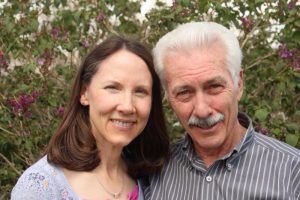
 After spending the majority of her life as a Labor and Delivery nurse, my sister-in-law, Jennifer Parmely retired from Wyoming Medical Center in Casper, Wyoming on Feb 23, 2023. Jennifer decided to keep her license until the next time it came up for renewal, and then let it go. She would no longer be a registered nurse. Of course, that doesn’t change the fact that she is still and always will be a nurse, but she wouldn’t be licenses to practice anymore. Still, she is available for her family is any of them need any nursing insight, but she couldn’t act in any official capacity. Her niece, my daughter Corrie Petersen decided to follow in her aunt’s footsteps and be a nurse too. Jennifer definitely inspired her.
After spending the majority of her life as a Labor and Delivery nurse, my sister-in-law, Jennifer Parmely retired from Wyoming Medical Center in Casper, Wyoming on Feb 23, 2023. Jennifer decided to keep her license until the next time it came up for renewal, and then let it go. She would no longer be a registered nurse. Of course, that doesn’t change the fact that she is still and always will be a nurse, but she wouldn’t be licenses to practice anymore. Still, she is available for her family is any of them need any nursing insight, but she couldn’t act in any official capacity. Her niece, my daughter Corrie Petersen decided to follow in her aunt’s footsteps and be a nurse too. Jennifer definitely inspired her.
That makes no difference, really, because these days her life revolves around her physical activities, such as 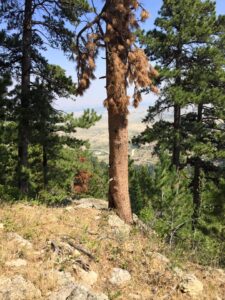
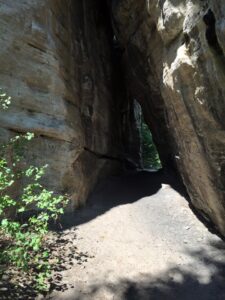 activities such as hiking, skiing, biking, and any number of other sports. She and her partner, Brian Cratty own a cabin on Casper Mountain, and they love to spend time in the solitude of their land. There are a number of trails on the mountain that she enjoys hiking on, an d it keeps her in tip top shape.
activities such as hiking, skiing, biking, and any number of other sports. She and her partner, Brian Cratty own a cabin on Casper Mountain, and they love to spend time in the solitude of their land. There are a number of trails on the mountain that she enjoys hiking on, an d it keeps her in tip top shape.
But her physical activities aren’t the only things Jennifer loves to do. She is Oma to four beautiful grandchildren…three girls and one boy. They and her children are truly her world. Each year on their birthdays, they get to have a special day with Oma, just them. They get to pick out the kind of birthday cake she will make for them, and the often get to spend the night with her too. She always makes their day a super special one. They are all getting so grown up these days, and I suppose those days might one day come to an end, but I think Jennifer will keep up the tradition for as long as she can.

 Jennifer and her daughter-in-law, Kelli Schulenberg both like to hike, and love spending time on the mountain in the summer walking the trails. Sometimes the grandchildren, her boys, and her other daughter-in-law, might join them too, but often it’s Brian who has been her hiking partner, as well as her life partner. They also like to bike the trails, and so they make use of the trails that way too. I know that while she doesn’t mind the Winter season, Jennifer always looks forward to the Summer’s warmth and the many hours she will spend on the mountain. Today is Jennifer’s birthday. Happy birthday Jennifer, Have a great day!! We love you!!
Jennifer and her daughter-in-law, Kelli Schulenberg both like to hike, and love spending time on the mountain in the summer walking the trails. Sometimes the grandchildren, her boys, and her other daughter-in-law, might join them too, but often it’s Brian who has been her hiking partner, as well as her life partner. They also like to bike the trails, and so they make use of the trails that way too. I know that while she doesn’t mind the Winter season, Jennifer always looks forward to the Summer’s warmth and the many hours she will spend on the mountain. Today is Jennifer’s birthday. Happy birthday Jennifer, Have a great day!! We love you!!
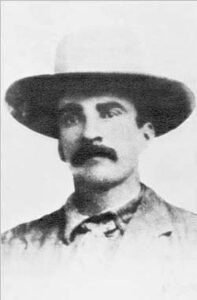 Scott Cooley, who was born in Texas around 1845, spent his early years as an honorable man, and in fact served as a Texas Ranger. When he met Johnny Ringo, all those years of being a good man ended. Cooley got involved in the Mason County War, and that was where he met Ringo.
Scott Cooley, who was born in Texas around 1845, spent his early years as an honorable man, and in fact served as a Texas Ranger. When he met Johnny Ringo, all those years of being a good man ended. Cooley got involved in the Mason County War, and that was where he met Ringo.
Cooley’s life wasn’t an easy one. He was orphaned as a young boy, when Native Americans killed his parents. While he was truly alone, he was unofficially adopted and raised by a rancher named Tim Williamson and his wife, who nursed him through Typhoid as a child. Cooley grew up to have a great deal of respect for the couple, which would later come into play at the eruption of the Mason County War.
When Cooley joined the Texas Rangers, as a young man, he served in Captain Cicero R Perry’s Company D. He quickly earned recognition for his relentless pursuit of outlaws. He was considered very dedicated and loyal. Then, in an odd move, Cooley resigned in 1875. He then took up farming and ranching near Maynardville, Texas. During this time, he and his benefactor, Tim Williamson, made two cattle drives to Kansas.
On May 13, 1875, Cooley’s life completely changed, when Deputy Sheriff John Worley arrested Tim Williamson on the suspicion of cattle rustling. It was the last straw. While Worley escorted Williamson to jail, an angry mob of German cattlemen abducted the prisoner and shot him to death. Thus began the Mason County War in Texas, which pitted the German cattlemen against the native-born Texans. Cooley blamed Worley for Williamson’s death, as he believed Worley had colluded with the German ambushers. He waited for the ambushers to be 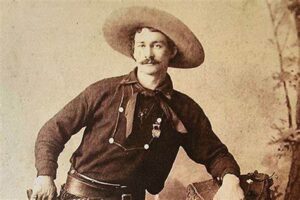 arrested but took matters into his own hands when no indictments were made against them.
arrested but took matters into his own hands when no indictments were made against them.
Cooley recruited several men to help him get his revenge, including John and Mose Beard, George Gladden, and Johnny Ringo. Then, the gang went out to avenge Tim Williamson’s death. Cooley and his “posse” went to Worley’s home, where he found the deputy working on his well with an assistant, who had been lowered over the side. Cooley shot Worley dead, and the well worker who was clinging to the rope, fell to the bottom of the well. To complete his revenge, Cooley scalped Worley, and proudly displayed his prize to the Germans. The gang went on to kill Peter Bader, who was believed to have been Williamson’s actual killer. They then tracked down another man named Daniel Hoerster, murdering him. Hoerster was suspected of having been part of the ambush group.
The actions of revenge were not going to be overlooked by the Germans, who retaliated. A posse led by Sheriff John Clark ambushed Mose Beard and George Gladden, killing Beard and seriously wounding Gladden. The sheriff’s posse included Charles Bader, brother to Cooley’s second victim, Peter Bader, who was after his own revenge. Not to be outdone, Cooley and his allies began to kill a number of the ambushers. This was to retaliate by the hanging of two of Cooley’s confederates. The killing continued back and forth for the next 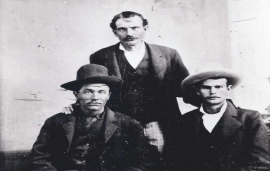 several months. The Texas Rangers were friends of Cooley’s, so they didn’t do much about it.
several months. The Texas Rangers were friends of Cooley’s, so they didn’t do much about it.
Scott Cooley and Johnny Ringo were arrested by Sheriff A J Strickland in December 1875. With the help of friends, they later escaped from the Lampasas County, Texas jail. Cooley later escaped from a posse at the Llano River. It was believed that he fled to Blanco County. There he lived with friends and died a short time later of brain fever. Only a few minor gunmen were ever charged for the revenge killings, but one was Johnny Ringo. He was acquitted. He would turn up later in Tombstone, Arizona, to tangle with the likes of Wyatt Earp.
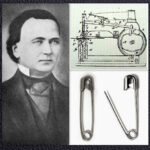
 Walter Hunt was a mechanic and independent inventor from New York. That basically meant he dabbled at inventions, but in this case, while he may not have realized the value of his invention, he would go on to invent on of the most important and versatile tools there is. The sad thing for Hunt is that because he didn’t realize what he had, he sold his patent for far less than its value. On April 10, 1849, Hunt sold the patent for his safety pin, unique with its metal loop that created a spring for just $400 ($16,502 today). While $16,502 sounds like a lot of money, the purchaser would go on to make millions off of Hunt’s invention. Hunt would never receive another penny.
Walter Hunt was a mechanic and independent inventor from New York. That basically meant he dabbled at inventions, but in this case, while he may not have realized the value of his invention, he would go on to invent on of the most important and versatile tools there is. The sad thing for Hunt is that because he didn’t realize what he had, he sold his patent for far less than its value. On April 10, 1849, Hunt sold the patent for his safety pin, unique with its metal loop that created a spring for just $400 ($16,502 today). While $16,502 sounds like a lot of money, the purchaser would go on to make millions off of Hunt’s invention. Hunt would never receive another penny.
Hunt was born on July 29, 1796, in Martinsburg, New York. Because he had a debt of $25 that he needed to pay, he scrambled to invent something that would earn him some money. Playing with a piece of metal wire, he twisted and turned it into what he called a “dress pin,” which had a spring at one end that forced the other end into a clasp. The invention wasn’t completely new, since ancient Romans used something similar for jewelry, but rather it was simply an improvement of the original design. Another version of a safety pin came out in 1842, but it had no spring, unlike the pins we know today. Hunt decided to patent his invention, and it was given US Patent Number 6,281. Today, many years later, Hunt’s design still has countless everyday uses, including fastening clothing and diapers. At one time a large version was used to adorn the outside of a wrap-around skirt.
The safety pin wasn’t his greatest invention, nor the one which brought him the most money, but it has 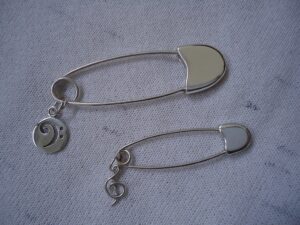
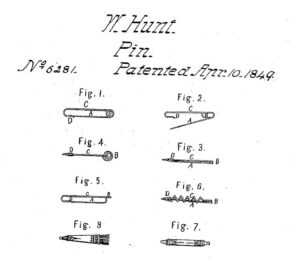 changed the lives of countless numbers of people to this day. In his lifetime, Hunt achieved moderate success and invented many items, including a repeating rifle, a flax spinner, a fountain pen, a knife sharpener, an ice plough, and one of the world’s first sewing machines with an eye-pointed needle. Hunt’s sewing machine actually triggered a patent dispute with another inventor, Elias Howe. He died of pneumonia at his place of business in New York City on June 8, 1859. He was 62 years old.
changed the lives of countless numbers of people to this day. In his lifetime, Hunt achieved moderate success and invented many items, including a repeating rifle, a flax spinner, a fountain pen, a knife sharpener, an ice plough, and one of the world’s first sewing machines with an eye-pointed needle. Hunt’s sewing machine actually triggered a patent dispute with another inventor, Elias Howe. He died of pneumonia at his place of business in New York City on June 8, 1859. He was 62 years old.

 Samuel Langhorne Clemens alias Mark Twain had a number of jobs before he became a famous writer. Clemens childhood was a difficult one, beginning with his premature birth on November 30, 1835, in Florida, Missouri. He was the sixth of seven children born to John Marshall Clemens and Jane Lampton Clemens. Only three of those children would survive to adulthood. Clemens, himself was sickly and frail until he was 7 years old. In 1839 the family moved to the town of Hannibal, Missouri. His popular novels “The Adventures of Tom Sawyer” and “Adventures of Huckleberry Finn” were set in a fictionalized version of Hannibal. John Marshall Clemens became a justice of the peace in Hannibal but struggled financially. Samuel Clemens was just 11 years old when his 49-year-old father died of pneumonia. Clemens’ life was about to change forever.
Samuel Langhorne Clemens alias Mark Twain had a number of jobs before he became a famous writer. Clemens childhood was a difficult one, beginning with his premature birth on November 30, 1835, in Florida, Missouri. He was the sixth of seven children born to John Marshall Clemens and Jane Lampton Clemens. Only three of those children would survive to adulthood. Clemens, himself was sickly and frail until he was 7 years old. In 1839 the family moved to the town of Hannibal, Missouri. His popular novels “The Adventures of Tom Sawyer” and “Adventures of Huckleberry Finn” were set in a fictionalized version of Hannibal. John Marshall Clemens became a justice of the peace in Hannibal but struggled financially. Samuel Clemens was just 11 years old when his 49-year-old father died of pneumonia. Clemens’ life was about to change forever.
In 1848, the year after his father’s death, Clemens went to work full-time as an apprentice printer at a newspaper in Hannibal. Remember that he was just a boy of 12 years at the time. In 1851, he moved over to a typesetting job at a local paper owned by his older brother, Orion. This would have been a promotion of sorts, but it also sparked something in him that would eventually make him the man what the world would know. He began to write a handful of short stories, and so began his lifelong writing career, although not on that exact day. He would have to do a few other things first. Nevertheless, some of his stories were published. In 1853, when he was 17 years old, Clemens left Hannibal and spent the next several years living in places such as New York City, Philadelphia and Keokuk, Iowa, and working as a printer.
In 1857, he decided to try something new, and signed on as a pilot’s apprentice on a river boat while on his way to Mississippi. He had been commissioned to write a series of comic travel letters for the Keokuk Daily Post, but after writing five, decided he’d rather be a pilot than a writer. this decision would also lead to a tragedy when, in 1858, while employed on a boat called the Pennsylvania, he got his younger brother, Henry, a job aboard the vessel. He worked on the Pennsylvania until early June. Then, on June 13, disaster struck when 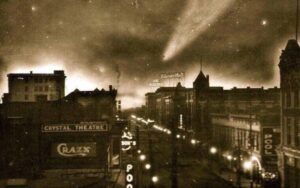 the Pennsylvania, traveling near Memphis, experienced a deadly boiler explosion. Among the dead was 19-year-old Henry. Nevertheless, Clemens continued to work as a pilot’s apprentice and on April 9, 1859, a 23-year-old Clemens received his steamboat pilot’s license. He piloted his own boats for two years, until the Civil War halted steamboat traffic. During his time as a pilot, he picked up the pseudonym “Mark Twain” from a boatman’s call noting that the river was only two fathoms deep, the minimum depth for safe navigation, hence Twain. When he returned to writing in 1861, working for the Virginia City Territorial Enterprise, he wrote a humorous travel letter signed by “Mark Twain” and continued to use the pseudonym for nearly 50 years.
the Pennsylvania, traveling near Memphis, experienced a deadly boiler explosion. Among the dead was 19-year-old Henry. Nevertheless, Clemens continued to work as a pilot’s apprentice and on April 9, 1859, a 23-year-old Clemens received his steamboat pilot’s license. He piloted his own boats for two years, until the Civil War halted steamboat traffic. During his time as a pilot, he picked up the pseudonym “Mark Twain” from a boatman’s call noting that the river was only two fathoms deep, the minimum depth for safe navigation, hence Twain. When he returned to writing in 1861, working for the Virginia City Territorial Enterprise, he wrote a humorous travel letter signed by “Mark Twain” and continued to use the pseudonym for nearly 50 years.
He moved to San Francisco in 1864, to work as a reporter. While there, he wrote the story that made him famous, “The Celebrated Jumping Frog of Calaveras County.” He traveled to Hawaii as a correspondent for the Sacramento Union in 1866. After his stint in Hawaii, he traveled the world writing accounts for papers in California and New York, which he later published as the popular book The Innocents Abroad in 1869. In 1870, when he was 35 years old, Clemens married Olivia Langdon, who was the daughter of a wealthy New York coal merchant and settled in Hartford, Connecticut, where he continued to write travel accounts and lecture. In 1875, his novel “Tom Sawyer” was published, followed by “Life on the Mississippi” in 1883, and his masterpiece “Huckleberry Finn” in 1885. Some bad investments left the Clemens family bankrupt after the publication of Huckleberry Finn, but he won back his financial standing with his next three books. He and Olivia had four children, their son Langdon died of diphtheria in 1872 at the age of 19 months. They also had three daughters: Susy (1872–1896), Clara (1874–1962), and Jean (1880–1909). Clara Clemens had one child, Nina Gabrilowitsch, who passed away in 1966, leaving no direct descendants of Samuel Clemens “Mark Twain.” Clemens and his family moved to Italy in 1903. Sadly, his wife died on June 5, 1904. Her death left him sad and bitter, and his work, while still humorous, grew distinctly darker. Clemens “Mark Twain” died in 1910. As he 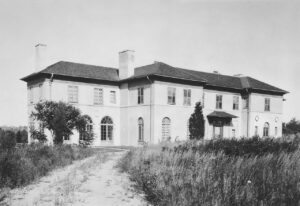
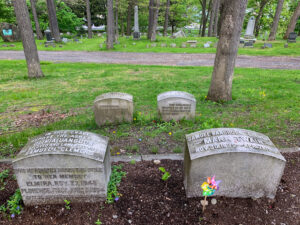 had predicted, or more likely chosen, “Mark Twain” died of a heart attack on April 21, 1910, at Stormfield, the mansion he had built in Redding, Connecticut…one day after Halley’s Comet was at its closest to the Sun and a month before the comet the passed near the Earth. I believe he was tired of living. He missed his wife, and most of his children had predeceased him. He was done, and simply ready to go home.
had predicted, or more likely chosen, “Mark Twain” died of a heart attack on April 21, 1910, at Stormfield, the mansion he had built in Redding, Connecticut…one day after Halley’s Comet was at its closest to the Sun and a month before the comet the passed near the Earth. I believe he was tired of living. He missed his wife, and most of his children had predeceased him. He was done, and simply ready to go home.
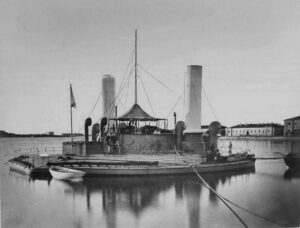
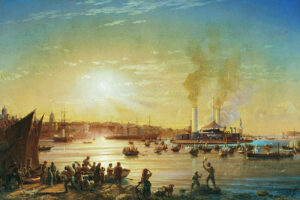 The Russian ship, Novgorod was a “monitor” built for the Imperial Russian Navy in the 1870s. A monitor is “a relatively small warship that is neither fast nor strongly armored but carries disproportionately large guns.” These ships were used by various navies from the 1860s, during the First World War and also has a limited presence in the Second World War. Novgorod was one of the most unusual warships ever constructed, and it is still considered in “popular naval myth” as one of the worst warships ever built. Whether it was a good warship or not, it certainly was one of the funniest looking warships of all time.
The Russian ship, Novgorod was a “monitor” built for the Imperial Russian Navy in the 1870s. A monitor is “a relatively small warship that is neither fast nor strongly armored but carries disproportionately large guns.” These ships were used by various navies from the 1860s, during the First World War and also has a limited presence in the Second World War. Novgorod was one of the most unusual warships ever constructed, and it is still considered in “popular naval myth” as one of the worst warships ever built. Whether it was a good warship or not, it certainly was one of the funniest looking warships of all time.
While funny looking, Novgorod was relatively effective in her designed role as a coast-defense ship, and apparently there were reasons for the design of the ship. The hull was circular to reduce draught (In maritime terms, “draught” (also spelled “draft”) refers to the vertical distance between the waterline and the bottom of a ship’s hull (keel)123. It is a critical measurement that indicates how deep a vessel sits in the water.) Well, this ship definitely sat low in the water, so I guess “draught” was reduced with this funny looking ship. The design allowed the ship to carry much more armor and a heavier armament than other ships of the same size. While she was funny looking, Novgorod played a minor role in the Russo-Turkish War of 1877–78 and was reclassified as a coast-defense ironclad in 1892.
Scottish shipbuilder John Elder published an article in 1868, that indicated that widening the beam of a ship would reduce the area that needed to be protected and allow it to carry thicker armor and heavier, more powerful guns in comparison to a ship with a narrower beam, as was the typical practice of the day. I suppose that makes sense. The low riding craft might also be somewhat more difficult to see in battle. In addition, only a moderate increase in power would be required to match the speed of a normal ship. according to Elder. Then Director of Naval Construction of the Royal Navy, Sir Edward Reed, agreed with Elder’s conclusions. Rear-Admiral Andrei Alexandrovich Popov of the Imperial Russian Navy decided that to further expand on Elder’s concept by broadening the ship, and in the end, it was actually circular and flat-bottomed, unlike Elder’s convex hull, to further minimize its draught. Thus, the funny looking monitor (also known as a popovkas) was born.
In his book, The World’s Worst Warships, naval historian Antony Preston characterized the popovkas like this: “But in other respects, they were a dismal failure. They were too slow to stem the current in the Dniepr, and proved very difficult to steer. In practice the discharge of even one gun caused them to turn out of control and 
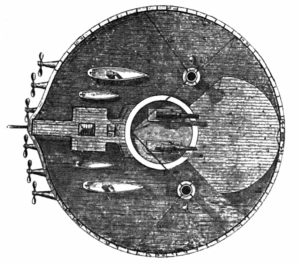 even contra-rotating some of six propellers was unable to keep the ship on the correct heading. Nor could they cope with the rough weather which is frequently encountered in the Black Sea. They were prone to rapid rolling and pitching in anything more than a flat calm and could not aim or load their guns under such circumstances.” The Novgorod popovkas ship was decommissioned in 1903 and used as a storeship until she was sold for scrap in 1911.
even contra-rotating some of six propellers was unable to keep the ship on the correct heading. Nor could they cope with the rough weather which is frequently encountered in the Black Sea. They were prone to rapid rolling and pitching in anything more than a flat calm and could not aim or load their guns under such circumstances.” The Novgorod popovkas ship was decommissioned in 1903 and used as a storeship until she was sold for scrap in 1911.


 Life has changed quite a bit for my niece, Chantel Balcerzak over the past year. Since her daughter, Siara Kirk and her husband, Chris bought the house next door to Chantel and her husband, Dave Balcerzak, and then had a sweet baby boy named Nathanial, Chantel has been helping them by babysitting their sweet boy. It has been a great thing for everyone. Siara and Chris know that when they are working, their baby boy is having a great time with his grandma, and that makes going to work much easier for them. Leaving your baby with a sitter isn’t always easy, but it’s a whole lot easier when the sitter is Grandma. Chantel has three other grandchildren, as well as one sweet baby boy, Alec, who lives in Heaven. She enjoys spending time with each and every one of them.
Life has changed quite a bit for my niece, Chantel Balcerzak over the past year. Since her daughter, Siara Kirk and her husband, Chris bought the house next door to Chantel and her husband, Dave Balcerzak, and then had a sweet baby boy named Nathanial, Chantel has been helping them by babysitting their sweet boy. It has been a great thing for everyone. Siara and Chris know that when they are working, their baby boy is having a great time with his grandma, and that makes going to work much easier for them. Leaving your baby with a sitter isn’t always easy, but it’s a whole lot easier when the sitter is Grandma. Chantel has three other grandchildren, as well as one sweet baby boy, Alec, who lives in Heaven. She enjoys spending time with each and every one of them.
Not only do Chantel and Dave live next door to Siara, Chris, and Nathaniel, but they are also best friends. They 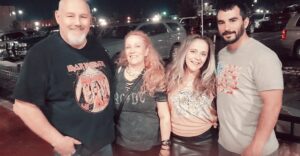 really enjoy doing things together. They love to attend concerts and football games and do so as often as possible. Chantel may not be the sports enthusiast that her husband or children are, but she very much enjoys the trips they have taken to the games. She enjoys travel, and if given the opportunity, she will gladly go. The concerts are a real favorite for her too.
really enjoy doing things together. They love to attend concerts and football games and do so as often as possible. Chantel may not be the sports enthusiast that her husband or children are, but she very much enjoys the trips they have taken to the games. She enjoys travel, and if given the opportunity, she will gladly go. The concerts are a real favorite for her too.
Since she was a little girl, Chantel has always had a flair for the artistic…be it art, makeup, or fashion. Always the diva, Chantel always knew just how to pose to make the photograph being takes of her looked really great. She loves to paint, and has completed several murals, my favorite being the one she did on the wall in the backyard of her sister, Toni and husband, Dave Chase’s house. They love it too, and it gives their yard a beautiful mountain scene. You can actually feel like you are really in the mountains.
Being an artist, Chantel is also very good at interior design. Her house is beautiful, and on that I would always  like to emulate…since I am not an artist or an interior designer. Chantel’s house has a distinctly feminine flair to it, but the “woman’s touch” in her house doesn’t bother her husband Dave one bit. I think he likes that his house has a “woman’s touch.” It makes him feel loved. I think every man wants to feel “taken care of” especially in their home, and Chantel’s knack for design truly makes him feel that way. Today is Chantel’s birthday. Happy birthday Chantel!! Have a great day!! We love you!!
like to emulate…since I am not an artist or an interior designer. Chantel’s house has a distinctly feminine flair to it, but the “woman’s touch” in her house doesn’t bother her husband Dave one bit. I think he likes that his house has a “woman’s touch.” It makes him feel loved. I think every man wants to feel “taken care of” especially in their home, and Chantel’s knack for design truly makes him feel that way. Today is Chantel’s birthday. Happy birthday Chantel!! Have a great day!! We love you!!

